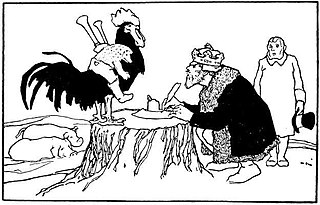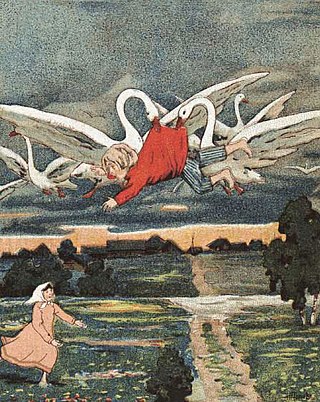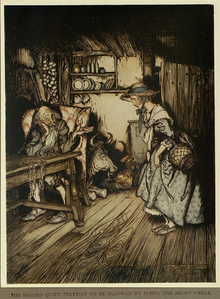
"Hansel and Gretel" is a German fairy tale collected by the German Brothers Grimm and published in 1812 in Grimm's Fairy Tales. It is also known as Little Step Brother and Little Step Sister.
The Aarne–Thompson–Uther Index is a catalogue of folktale types used in folklore studies. The ATU Index is the product of a series of revisions and expansions by an international group of scholars: originally composed in German by Finnish folklorist Antti Aarne (1910), the index was translated into English, revised, and expanded by American folklorist Stith Thompson, and later further revised and expanded by German folklorist Hans-Jörg Uther (2004). The ATU Index, along with Thompson's Motif-Index of Folk-Literature (1932) - with which it is used in tandem, is an essential tool for folklorists.

"Hans My Hedgehog" is a German fairy tale collected by the Brothers Grimm. The tale was translated as Jack My Hedgehog by Andrew Lang and published in The Green Fairy Book. It is of Aarne-Thompson type 441.

"East of the Sun and West of the Moon" is a Norwegian fairy tale. It was included by Andrew Lang in The Blue Fairy Book (1890).
The Brown Bear of Norway is an Irish fairy tale collected by Patrick Kennedy which appeared in his Legendary Fictions of the Irish Celts (1866). It was later included by Andrew Lang in his anthology The Lilac Fairy Book (1910), though Lang misattributed his source as West Highland Tales.

The Iron Stove is a fairy tale collected by the Brothers Grimm, as tale number 127. It is Aarne–Thompson type 425A, the animal bridegroom. Dorothea Viehmann prepared the story for the Grimms' collection.
"One-Eye, Two-Eyes, and Three-Eyes" is a German fairy tale collected by the Brothers Grimm, tale number 130. Andrew Lang included it, as "Little One-eye, Little Two-eyes, and Little Three-eyes", in The Green Fairy Book. It is Aarne-Thompson type 511.
"The Glass Coffin" is a German fairy tale collected by the Brothers Grimm, tale number 163. Andrew Lang included it in The Green Fairy Book as The Crystal Coffin.
The Tale of the Hoodie is a Scottish fairy tale, collected by John Francis Campbell in his Popular Tales of the West Highlands. Andrew Lang included it, as The Hoodie-Crow, in The Lilac Fairy Book.
The Sprig of Rosemary is a Spanish fairy tale collected by Dr. D. Francisco de S. Maspons y Labros in Cuentos Populars Catalans. Andrew Lang included it in The Pink Fairy Book.
"Old Sultan" is a German fairy tale collected by the Brothers Grimm.
The Ram is a French literary fairy tale by Madame d'Aulnoy.
The Grateful Prince is an Estonian fairy tale.

"The Twelve Brothers" is a German fairy tale collected by the Brothers Grimm in Grimm's Fairy Tales. Andrew Lang included it in The Red Fairy Book.
The Daughter of the Skies is a Scottish fairy tale collected by John Francis Campbell in Popular Tales of the West Highlands, listing his informant as James MacLauchlan, a servant from Islay.
Habogi is an Icelandic fairy tale published in Neuislandische Volksmärchen by linguist Adeline Rittershaus. Andrew Lang included it in The Brown Fairy Book.

The King of England and his Three Sons is a Romani fairy tale collected by Joseph Jacobs in More English Fairy Tales. He listed as his source Francis Hindes Groome's In Gypsy Tents, where the informant was John Roberts, a Welsh Roma. Groome published the tale as An Old King and his three Sons in England.

The Magic Swan Geese or Гуси-лебеди is a Russian fairy tale collected by Alexander Afanasyev in Narodnye russkie skazki, numbered 113.
The Snake Prince is an Indian fairy tale, a Punjabi story collected by Major Campbell in Feroshepore. Andrew Lang included it in The Olive Fairy Book (1907).
In folkloristics, "The Animal as Bridegroom" refers to a group of folk and fairy tales about a human woman marrying or being betrothed to an animal. The animal is revealed to be a human prince in disguise or under a curse. Most of these tales are grouped in the international system of Aarne-Thompson-Uther Index under type ATU 425, "The Search for the Lost Husband". Some subtypes exist in the international classification as independent stories, but they sometimes don't adhere to a fixed typing.







